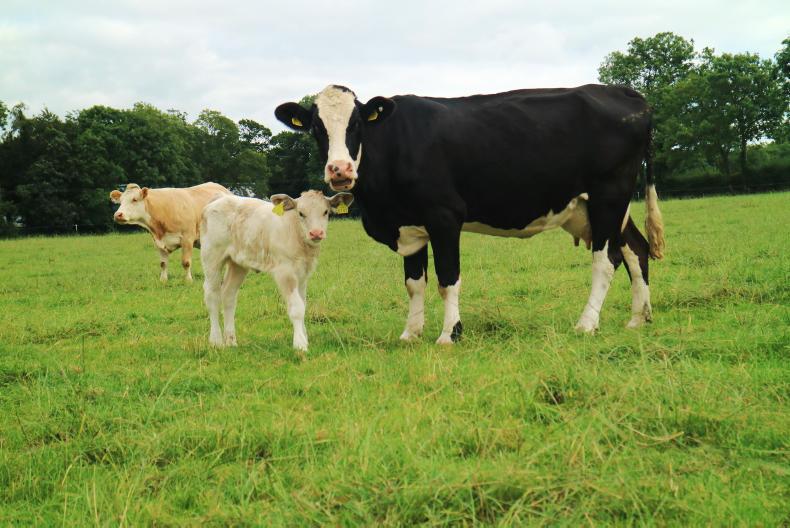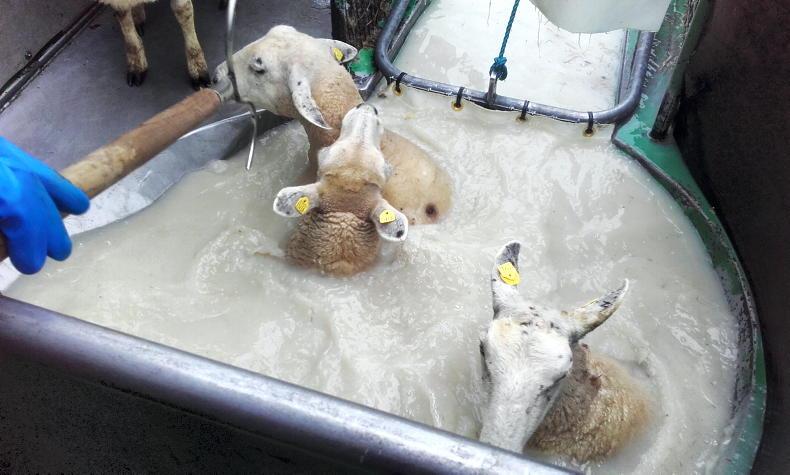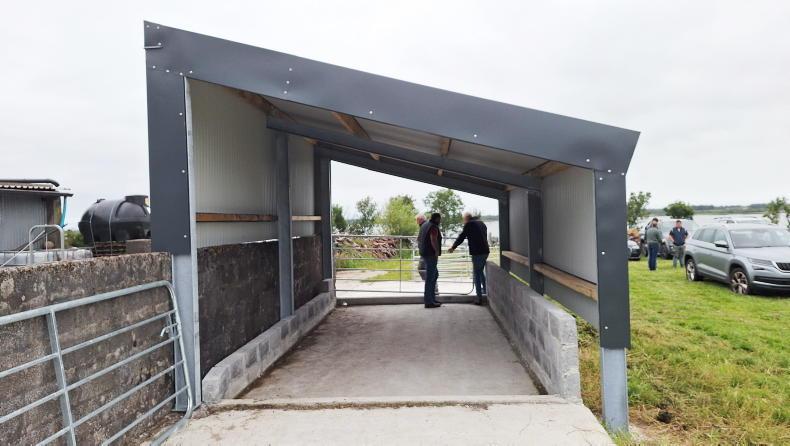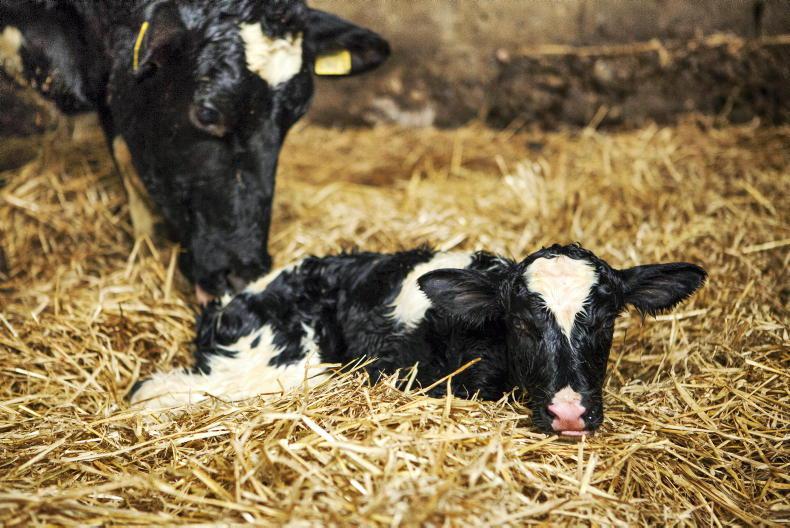James Madigan keeps 80 suckler cows at Ballyhale in Co Kilkenny. The farm will consist of 85ha in 2016, up from 57ha in 2012. The herd’s calving patterns are evenly split into two defined periods: January to March and August to September. In 2015, average calving interval was 366 days and James achieved an annual calves per cow figure of 0.96 – exceptional cow performance.
James buys in Simmental X British Friesian replacement heifers from a local dairy farmer for his autumn herd and breeds his own spring replacements from his autumn herd using AI. Anatrim Bodybuilder (AYX) was James’s bull of choice for breeding spring replacements in 2015 and his first calves are exceptional.
While not your run of the mill replacement strategy, it is working fantastically well for James.
Simmental x British Friesian
“I love that Simmy/British Friesian cross. She’s quiet and has oceans of milk. My spring calves’ average weight gain from birth to weaning was 1.1kg daily in 2015. Then, I’ll cross her back to a continental bull using AI when they’re in the shed, looking for heifers for the spring herd. It means that my spring-calving heifers are around 30 months at calving. Although we’re advised to go younger, I like them having good size when calving first. I’m using an easy-calving Belgian Blue AI bull (STQ, calving difficulty 9.7%) on my spring-calving heifers, which again is going against the grain. But I’ve had no problems thus far. I suppose the fact that heifers are that bit bigger at calving is a help.
At present, bullocks are being killed at 24 months and heifers at 22 months. He targets a carcase weight of 420kg for bullocks and 350kg for heifers. However, 2017 will see a complete change of system for James.
“I’m going down the under-16-month (U16) bull route, for a couple of reasons. I want to eventually end up at 100 cows – that’ll put pressure on shed space here. An U16 bull needs only one winter, which will allow me to house more cows and grow the breeding herd. Secondly, I found that my steers were getting too heavy in a 24-month system. Going forward, there will probably be carcase weight issues the way I’m heading. They were probably coming in too heavy for finishing, but if I’d brought them in much earlier, the benefits of cheap weight gain on grass would’ve been diluted. That said, I’m planning to slaughter my last batch of bullocks, 2015’s spring calves, a bit younger at the end of this year. The move to an U16 bull will also leave me with less stock groups to manage at grass. Farmers don’t value their labour and time enough! It’s going to be a big change, but seeing that those doing an U16 bull achieved the healthiest profits of all the BETTER farmers in 2015 gives me peace of mind that it’s the right choice.”
Dairy culls
James has been one of the more successful steer-beef producers in the BETTER farm programme and in 2015 he surpassed the target gross margin of €1,000/ha. What’s all the more impressive is that he has managed to maintain or increase the farm’s profitability per hectare, while expanding the farm. Normally as a farm grows in acreage, this figure takes a hit – farmers can be slow to stock new ground due to financial constraints. But James has been quick to push on new land coming into the system, upping cow numbers and buying in stock to add an output dimension. This year he has chosen to buy in cull dairy cows.
“It might seem sacrilegious to some beef men (we all love shapey, coloured cattle) but I can get these cull dairy cows cheap, send them off to an outfarm and let them flesh up at grass – it’s all beef at the end of the day. They’re less hassle than rearing dairy calves. One of the most important lessons that the programme has taught me is that you should match your stocking rate to your farm’s grass growing potential. Very few Irish beef farmers are near achieving this. These cows help me to bring the two closer.”
Health headaches
It hasn’t all been plain sailing for James Madigan. As cattle numbers have grown in recent years, so too have health headaches. Since joining the programme in 2011, James has had outbreaks of IBR (losing six calves), rotavirus, cryptosporidium and salmonella (which lead to eight abortions). The fact that he has recovered and successfully hit the €1,000/ha target is a sign of his resilience and drive.
“The health issues put the brake on my plans alright. It seemed to be just one thing after another for a while. You have to get on with things though. I fully believe it was down to the growing numbers. I was buying in animals before and not having any problems. But when cattle got more concentrated on the farm and numbers really started to climb, the outbreaks started. I wasn’t vaccinating for anything except blackleg and my strategies around calving hygiene were by the book – it had worked before, but it wasn’t enough when the numbers increased.”
Now James vaccinates young calves against bacterial pneumonia and IBR at nine days of age. Cows get vaccinated against IBR, salmonella, leptospirosis and rotavirus too. “My vet bill has jumped drastically, but look at it this way: I had eight abortions with the salmonella outbreak at a time when I was trying to boost numbers. You could pay for vaccinations for 10 or 20 years with the money I lost at that. Even when the crypto hit, we lost no calves but I had to live in the shed with them for weeks – what’s my time worth? In hindsight, the calves probably weaned much lighter at the end of the year. When boosting stock numbers you need to boost your impetus on herd health too.
Summer mastitis
Since James began vaccinating, he has had no issues with any of the above diseases. But this year, there’s a fresh headache – summer mastitis is rearing its ugly head.
“As soon as I wean the autumn calves [early June], it starts. I’m culling 10 cows this year, most of them reluctantly, all because of summer mastitis. At present, they’re getting Spot On twice – at weaning and one month later – and I’m spraying them with sheep dip using the knapsack, but it’s not enough. My vet is going to put non-antimicrobial sealers in the teats next year as soon as cows are weaned. It may be drastic, but he’s confident it’ll work.”
Read more
Increased market exposure for beef farmers in future
James Madigan keeps 80 suckler cows at Ballyhale in Co Kilkenny. The farm will consist of 85ha in 2016, up from 57ha in 2012. The herd’s calving patterns are evenly split into two defined periods: January to March and August to September. In 2015, average calving interval was 366 days and James achieved an annual calves per cow figure of 0.96 – exceptional cow performance.
James buys in Simmental X British Friesian replacement heifers from a local dairy farmer for his autumn herd and breeds his own spring replacements from his autumn herd using AI. Anatrim Bodybuilder (AYX) was James’s bull of choice for breeding spring replacements in 2015 and his first calves are exceptional.
While not your run of the mill replacement strategy, it is working fantastically well for James.
Simmental x British Friesian
“I love that Simmy/British Friesian cross. She’s quiet and has oceans of milk. My spring calves’ average weight gain from birth to weaning was 1.1kg daily in 2015. Then, I’ll cross her back to a continental bull using AI when they’re in the shed, looking for heifers for the spring herd. It means that my spring-calving heifers are around 30 months at calving. Although we’re advised to go younger, I like them having good size when calving first. I’m using an easy-calving Belgian Blue AI bull (STQ, calving difficulty 9.7%) on my spring-calving heifers, which again is going against the grain. But I’ve had no problems thus far. I suppose the fact that heifers are that bit bigger at calving is a help.
At present, bullocks are being killed at 24 months and heifers at 22 months. He targets a carcase weight of 420kg for bullocks and 350kg for heifers. However, 2017 will see a complete change of system for James.
“I’m going down the under-16-month (U16) bull route, for a couple of reasons. I want to eventually end up at 100 cows – that’ll put pressure on shed space here. An U16 bull needs only one winter, which will allow me to house more cows and grow the breeding herd. Secondly, I found that my steers were getting too heavy in a 24-month system. Going forward, there will probably be carcase weight issues the way I’m heading. They were probably coming in too heavy for finishing, but if I’d brought them in much earlier, the benefits of cheap weight gain on grass would’ve been diluted. That said, I’m planning to slaughter my last batch of bullocks, 2015’s spring calves, a bit younger at the end of this year. The move to an U16 bull will also leave me with less stock groups to manage at grass. Farmers don’t value their labour and time enough! It’s going to be a big change, but seeing that those doing an U16 bull achieved the healthiest profits of all the BETTER farmers in 2015 gives me peace of mind that it’s the right choice.”
Dairy culls
James has been one of the more successful steer-beef producers in the BETTER farm programme and in 2015 he surpassed the target gross margin of €1,000/ha. What’s all the more impressive is that he has managed to maintain or increase the farm’s profitability per hectare, while expanding the farm. Normally as a farm grows in acreage, this figure takes a hit – farmers can be slow to stock new ground due to financial constraints. But James has been quick to push on new land coming into the system, upping cow numbers and buying in stock to add an output dimension. This year he has chosen to buy in cull dairy cows.
“It might seem sacrilegious to some beef men (we all love shapey, coloured cattle) but I can get these cull dairy cows cheap, send them off to an outfarm and let them flesh up at grass – it’s all beef at the end of the day. They’re less hassle than rearing dairy calves. One of the most important lessons that the programme has taught me is that you should match your stocking rate to your farm’s grass growing potential. Very few Irish beef farmers are near achieving this. These cows help me to bring the two closer.”
Health headaches
It hasn’t all been plain sailing for James Madigan. As cattle numbers have grown in recent years, so too have health headaches. Since joining the programme in 2011, James has had outbreaks of IBR (losing six calves), rotavirus, cryptosporidium and salmonella (which lead to eight abortions). The fact that he has recovered and successfully hit the €1,000/ha target is a sign of his resilience and drive.
“The health issues put the brake on my plans alright. It seemed to be just one thing after another for a while. You have to get on with things though. I fully believe it was down to the growing numbers. I was buying in animals before and not having any problems. But when cattle got more concentrated on the farm and numbers really started to climb, the outbreaks started. I wasn’t vaccinating for anything except blackleg and my strategies around calving hygiene were by the book – it had worked before, but it wasn’t enough when the numbers increased.”
Now James vaccinates young calves against bacterial pneumonia and IBR at nine days of age. Cows get vaccinated against IBR, salmonella, leptospirosis and rotavirus too. “My vet bill has jumped drastically, but look at it this way: I had eight abortions with the salmonella outbreak at a time when I was trying to boost numbers. You could pay for vaccinations for 10 or 20 years with the money I lost at that. Even when the crypto hit, we lost no calves but I had to live in the shed with them for weeks – what’s my time worth? In hindsight, the calves probably weaned much lighter at the end of the year. When boosting stock numbers you need to boost your impetus on herd health too.
Summer mastitis
Since James began vaccinating, he has had no issues with any of the above diseases. But this year, there’s a fresh headache – summer mastitis is rearing its ugly head.
“As soon as I wean the autumn calves [early June], it starts. I’m culling 10 cows this year, most of them reluctantly, all because of summer mastitis. At present, they’re getting Spot On twice – at weaning and one month later – and I’m spraying them with sheep dip using the knapsack, but it’s not enough. My vet is going to put non-antimicrobial sealers in the teats next year as soon as cows are weaned. It may be drastic, but he’s confident it’ll work.”
Read more
Increased market exposure for beef farmers in future












SHARING OPTIONS